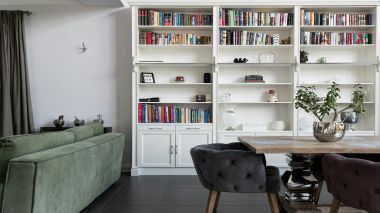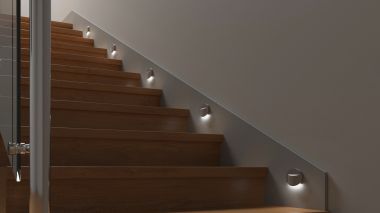Energy audit – everything you need to know about it
Lighting plays a significant role in an energy audit. It is one of the key areas that can improve the energy efficiency of buildings. Wondering how to maintain efficiency and quality while saving money? Opt for LED lighting.

What is an energy audit?
An energy audit is a detailed analysis of the energy consumption of a building in which a company or institution is located, which has an identified energy consumption, the possibility of reducing it and thus improving energy efficiency and reducing the costs associated with energy consumption. What does an energy audit look like? What is its scope? It includes a review of lighting, heating, ventilation and cooling equipment, thermal insulation and other energy-consuming systems. What is its objective? Optimisation of efficiency and reduction of energy consumption.
During an energy audit, specialists analyse energy consumption data, examine the technical condition of installations and assess the energy efficiency of the facility. Based on the collected information, recommendations for modernisation, repairs or changes are developed to improve energy efficiency. These recommendations may include installing more energy-efficient equipment, as well as significant modernisation work such as building insulation.
Scope of an energy audit
What does an energy audit consist of and what does it look like? It is a series of measurements and analyses. Its main elements are the determination of past energy consumption, an inspection of the building in terms of the condition of the equipment, the identification of energy consumption points, an analysis of the efficiency of the equipment, control systems and thermal insulation. Finally, an assessment and a report are made, indicating areas for improvement.
Of course, not every audit will look the same. It has to be tailored to the specific needs and characteristics of the facility in question, but it usually covers the above points.
Energy audits are worthwhile and necessary, especially if you run your own business. The amount that can be saved with small changes will be significant, regardless of whether you run a small shop or a large production hall. It can also be useful when renting real estate, certifying buildings, or environmental actions aimed at reducing greenhouse gas emissions.
Did you know that...
You can carry out a small lighting audit at home. List all light sources (integrated lamps and bulbs), check their power and how much light they provide. Find a light with the same number of lumens (W) but less energy consumption (W). Calculate how much you can save. You can do the same with all electrical appliances in your home. Replacing them with more efficient ones will reduce electricity consumption, which, with constantly rising prices, can pay off much faster than you think.
Example? Kanlux XLED EX generates the same amount of light as a traditional 60W bulb, but its energy consumption is 15 times lower (3.8W)!
We suggest starting with small things, or, if your budget allows, getting everything in bulk. A few light bulbs, a bedside lamp, a toaster, or an electric kettle will surely be a good start – make sure to pay attention to the energy efficiency class.
Improving energy efficiency with lighting
Basic types of light sources, such as traditional incandescent bulbs, fluorescent lamps, or halogen sources, are gradually being phased out in favour of more energy-efficient technologies, such as light-emitting diodes (LEDs). An energy audit includes an assessment of the efficiency of existing sources, paying attention to their energy consumption (in relation to the amount of light emitted), durability, and operating costs.
And when it comes to costs - reducing them is one of the main reasons, so it's worth considering lighting modernisation after an energy audit. In industry, savings can range from 30% to 80%! This investment will pay off quickly, especially if you ask for help from specialists. The Kanlux team is able to tailor the offer to specific requirements, focus on order personalisation, and at the same time propose the most efficient solutions in terms of energy savings.
It is worth opting for solutions tailored directly to specific types of businesses, e.g. production plants or industrial halls and warehouses. High-bay luminaires consume the most electrical energy. This type of lamp with 150W metal halide sources gives us around 12,000 lumens of light. In comparison, two years ago a similar LED luminaire provided 17,000 lumens of light at the same wattage. Today we can get 22,000 lumens with the same power. In addition, there is much greater durability of LED sources (5 years warranty, 50,000 hours of operation), which are constantly being improved. Therefore, legal regulations recommend repeating the audit every 4 years.
Lighting management
Effective lighting control is a key element in improving energy efficiency. As part of an energy audit, lighting control systems such as motion sensors, timers, and intelligent management systems are analysed. Properly adjusting the lighting operating time to actual needs can significantly reduce energy consumption.
Kanlux SMART is a simple system that focuses on basic solutions that can be successfully implemented in small offices or exhibition spaces. For larger areas, motion or presence sensors will be effective. The PIR SENTO-O motion sensor has as many as three infrared detectors. This means that it is extremely sensitive and detects even the slightest of movements (so-called Presence detector). It can be flush-mounted as well as surface-mounted.
More advanced control systems such as DALI, for example, will work well in production facilities or high storage halls. All luminaires from the Kanlux Factory can be successfully fitted with DALI and Casambi Ready control.
An energy audit is an incredibly important tool in striving to improve the energy efficiency of buildings and facilities. Focusing on lighting modernisation as one of the key elements of this process will help us save on energy costs and reduce operating expenses. By implementing more efficient lighting technologies and intelligent control systems, long-term economic benefits can be achieved. If you want to learn more, please feel free to contact Kanlux experts.
Other articles
 How to light your home library and reading space?
How to light your home library and reading space?
Reading is one of those activities that truly allows you to pause—to break away from everyday life...
 Lighting for Mezzanine Floors and High Spaces — Challenges and Solutions
Lighting for Mezzanine Floors and High Spaces — Challenges and Solutions
Not every space has the grandeur of a cathedral — and that is quite fortunate. Low interiors, mezzanine...
 Staircase and Corridor Lighting — Safety and Design
Staircase and Corridor Lighting — Safety and Design
Stairs, corridors and other passageways have specific lighting requirements. This is not only for safety...
 Smart lighting management in your home – where to start?
Smart lighting management in your home – where to start?
Smart lighting systems are not only a matter of convenience, but also a conscious step towards better...
 How does LED lighting work?
How does LED lighting work?
The LED lighting in our homes, offices and public areas is here to stay. Today, it is hard to imagine...
 How can lighting create a spa atmosphere in your bathroom?
How can lighting create a spa atmosphere in your bathroom?
When designing a bathroom, not only aesthetics but also lighting matter—when selected appropriately,...